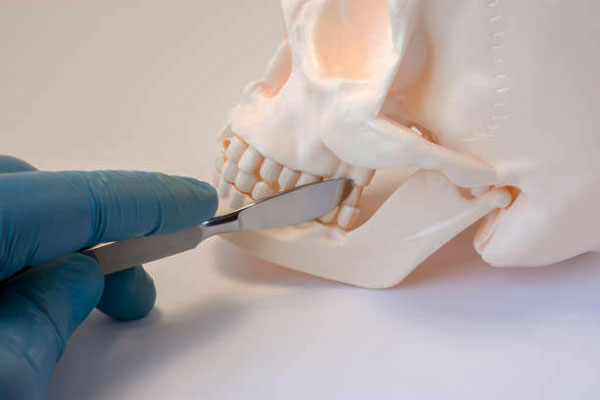Osteotomy of the Jaw
Jaw deformities are conditions caused by growth differences in the upper jaw, lower jaw, or both. Besides growth differences, genetic factors, trauma, and certain birth defects also lead to jaw deformities. It will result in improper alignment of teeth, difficulty chewing, difficulty swallowing, receding chins, and a change in facial appearance. When these conditions can't be resolved with orthodontics (correction of misaligned teeth and jaws using dental braces) alone, a corrective surgery known as a jaw osteotomy is recommended.

What is jaw osteotomy?
Jaw osteotomy is a surgical procedure for the correction of dentofacial deformities. This is also known as corrective jaw surgery, where the irregularities, including the misalignment of the jaws and teeth, are corrected. A jaw osteotomy will also improve facial appearance.
There are mainly two types of jaw osteotomy procedures. These include upper jaw surgery (maxillary osteotomy) and lower jaw surgery (mandibular osteotomy). In most cases, either upper or lower jaw surgeries are carried out, but in some conditions, both procedures may be required.
When is jaw osteotomy recommended?
Jaw osteotomy is recommended when orthodontic treatment fails to correct the following problems:
- Difficulty chewing or incising foods
- Speech difficulties
- Obstructive sleep apnea
- Temporomandibular joint problems
- Facial imbalance
What are the pre-procedure care?
Jaw osteotomy surgery is planned by your orthodontist, orthopedic surgeon, and maxillofacial surgeon. The team will recommend X-ray studies of the surgical area to plan your jaw surgery. In some cases, medical modeling is used to plan your surgery, where accurate physical models are derived using 3-D CT scans and MRI scans.
An orthodontist will place braces on your teeth for 12-18 months in order to level and align your teeth before the procedure. In addition to these, you may be given certain pre-operative instructions, which include:
- Avoid some medications like aspirin, ibuprofen, etc. a week before surgery as they may have some undesirable effects that affect your surgery.
- No smoking prior to surgery.
- Make arrangements to go home after the procedure.
- On the day before the operation, avoid eating or drinking anything after midnight.
How is jaw osteotomy performed?
Surgery is usually done under general anesthesia, which puts you to sleep throughout the procedure. Once you are admitted to the hospital for the surgery, you will be examined by a member of the anesthesia team, and anesthesia will be administered.
Generally, the surgery is performed inside the mouth to avoid facial scars after the surgery. But in some cases, small incisions are required outside the mouth. During the procedure, the surgeon will make a cut in the affected jaw and align it in the correct position. Bone plates, screws, wires, or bands are used to secure the bones into their new position; these inserts will integrate into the bone structure over time.
For the application of the screws in the mandible, a small incision is required near the angle of the jaw. These incisions are small and usually require a single stitch to hold them together. In some cases, bone grafting is required to reshape the jaw, where a surgeon will transfer the bone from your hip, leg, or rib, place it in the affected area, and secure it with plates and screws.
What is the post-procedure care?
After you wake up from the anesthesia, you may experience pain and discomfort as you will have some small elastic bands between the upper and lower teeth, which will restrict the opening of your mouth.
Usually, you can go home the following day after surgery. Before discharging, your surgeon will provide the following instructions:
- Diet: You will be instructed to have a soft or liquid diet for the initial 4-5 weeks after the surgery. You can return to normal food after 6-8 weeks.
- Oral hygiene: You should brush your teeth and rinse with mouthwash twice daily. Rinse with hot water and salt after meals to keep the wounds clean and to remove food debris.
- Mdications: You will be given painkillers and a course of antibiotics, which should be taken as instructed.
- Activities: You must rest completely for the first week after the surgery. You can slowly resume most of your normal routine after the first week.
After an initial jaw healing period of about six weeks, you will have a follow-up visit to the hospital, where an orthodontist will examine the affected area and align your teeth with braces to hold the teeth in the correct position.
Outlook
Jaw osteotomy is considered a corrective surgery to correct jaw abnormalities resulting from various reasons. These are successful procedures for fixing jaw abnormalities and improving their function. Recovery after jaw osteotomy is relatively rapid, though it may vary among different patients and specific procedures.
A jaw osteotomy is also recommended as a cosmetic surgery to change the appearance of the face. It may be used for a receding chin, a protruding jaw, or lips that don’t meet.